
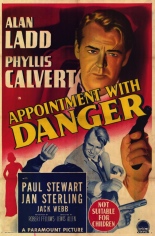 Appointment with Danger is one of those movies that come along every so often: one from which you don’t expect more than a mildly diverting 89 minutes, but turns out to be a small gem. The cast includes Alan Ladd and some favorite character actors — Jack Webb, Harry Morgan, Paul Stewart, Jan Sterling — that I’d like to kick back and have a beer with. The picture was credited as being film noir, so why not take a chance?
Appointment with Danger is one of those movies that come along every so often: one from which you don’t expect more than a mildly diverting 89 minutes, but turns out to be a small gem. The cast includes Alan Ladd and some favorite character actors — Jack Webb, Harry Morgan, Paul Stewart, Jan Sterling — that I’d like to kick back and have a beer with. The picture was credited as being film noir, so why not take a chance?
Ladd is Al Goddard, a postal inspector no one likes, sent to Gary, Ind., to investigate the murder of one of his colleagues. He finds that the only witness is a nun, Sister Augustine (Phyllis Calvert). As soon as they meet, you suspect that he will end up carrying an unlightable torch for her, but it doesn’t happen. They are both too dedicated to their jobs for such foolishness. Besides, she’s already married.
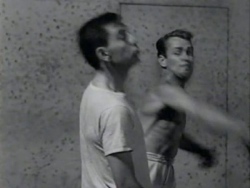 She saw only one of the killers (Morgan), but the other one (Webb) thinks she should be killed just to be on the safe side. Goddard goes undercover as a bent government man in order to find out what these crooks are up to, and how to stop it.
She saw only one of the killers (Morgan), but the other one (Webb) thinks she should be killed just to be on the safe side. Goddard goes undercover as a bent government man in order to find out what these crooks are up to, and how to stop it.
The pleasure comes from the obvious fun the cast is having and the surprisingly sharp dialogue, like Goddard defining love as the feeling a man has for a gun that doesn’t jam, and later, a great line perfectly delivered. When the crooks capture the nun, they decide to kill her, then Goddard talks them out of it and one of them turns to her and says, “Sister, you’re either very lucky or you’ve been living right.” To a nun, he says this, and no one onscreen reacts, despite the fact that it’s the dumbest thing they’ve ever heard. —Doug Bentin

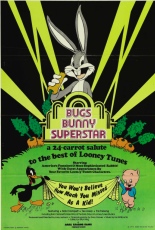
 It’s possible to be a movie lover and not like Greta Garbo or John Wayne or Humphrey Bogart, and still retain some credibility — but turn your nose up at Bugs Bunny and hell hath no depth too deep for you, you humorless poseur.
It’s possible to be a movie lover and not like Greta Garbo or John Wayne or Humphrey Bogart, and still retain some credibility — but turn your nose up at Bugs Bunny and hell hath no depth too deep for you, you humorless poseur. 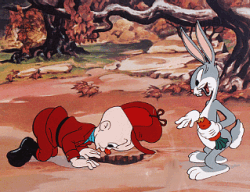 It’s this material, most of which is spoken by one of Bugs’ papas, Bob Clampett, that generated some hurt feelings when this film was released. Co-creators Avery and Friz Freleng are also interviewed, and while Clampett had complimentary things to say about Chuck Jones, Jones — who could nurse a grudge like Silas Marner could nurse a nickel — accused Clampett of being a credit hog. The thing is, when this picture was made, almost everyone from the days of classic animation was looking for credit for the work he’d done for hire in the 1930s-1950s, so a lot of exaggeration was going around.
It’s this material, most of which is spoken by one of Bugs’ papas, Bob Clampett, that generated some hurt feelings when this film was released. Co-creators Avery and Friz Freleng are also interviewed, and while Clampett had complimentary things to say about Chuck Jones, Jones — who could nurse a grudge like Silas Marner could nurse a nickel — accused Clampett of being a credit hog. The thing is, when this picture was made, almost everyone from the days of classic animation was looking for credit for the work he’d done for hire in the 1930s-1950s, so a lot of exaggeration was going around. 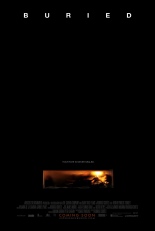
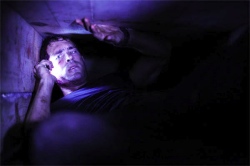 When I first saw the movie’s trailer, which includes the moment when an asp slithers into the coffin through a crack, I thought the film would be a tough sell — not because it plays so strongly on the common fear of enclosed places, but because its lack of action would bore younger audiences.
When I first saw the movie’s trailer, which includes the moment when an asp slithers into the coffin through a crack, I thought the film would be a tough sell — not because it plays so strongly on the common fear of enclosed places, but because its lack of action would bore younger audiences. 
 If you’re like me, you poor bastard, the title of this flick alone will land it in your Netflix queue. Then there’s the poster, depicting a pair of sexy, blood-spattered nurses. To hell with the queue — this one’s for instant streaming.
If you’re like me, you poor bastard, the title of this flick alone will land it in your Netflix queue. Then there’s the poster, depicting a pair of sexy, blood-spattered nurses. To hell with the queue — this one’s for instant streaming.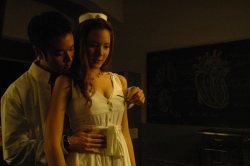 At this point, this goofy little film gets a bit more serious as directors Piraphan Laoyont and Thodsapol Siriwiwat go all surreal with the visuals. The hospital’s empty halls stop looking like ways to keep the budget down and start looking like corridors of the mind where bad things, and only bad things, ooze out of the walls or float along the ceiling.
At this point, this goofy little film gets a bit more serious as directors Piraphan Laoyont and Thodsapol Siriwiwat go all surreal with the visuals. The hospital’s empty halls stop looking like ways to keep the budget down and start looking like corridors of the mind where bad things, and only bad things, ooze out of the walls or float along the ceiling.
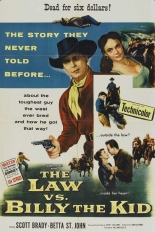 Before he became the Greater of Cheese, William Castle was an all-purpose director of schlock B movies at Columbia —
Before he became the Greater of Cheese, William Castle was an all-purpose director of schlock B movies at Columbia — 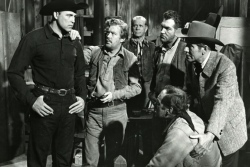 The script even sticks, with some slight degree of stickiness, to the outline of the Lincoln County War. Kid and Garrett are saddle pals — Kid goes off the rails to avenge the murder of his boss; Garrett is recruited to become Sheriff and track the Kid down. Kid busts out of jail; Kid is killed by Garrett at Pete Maxwell’s ranch near Roswell, N.M.
The script even sticks, with some slight degree of stickiness, to the outline of the Lincoln County War. Kid and Garrett are saddle pals — Kid goes off the rails to avenge the murder of his boss; Garrett is recruited to become Sheriff and track the Kid down. Kid busts out of jail; Kid is killed by Garrett at Pete Maxwell’s ranch near Roswell, N.M.